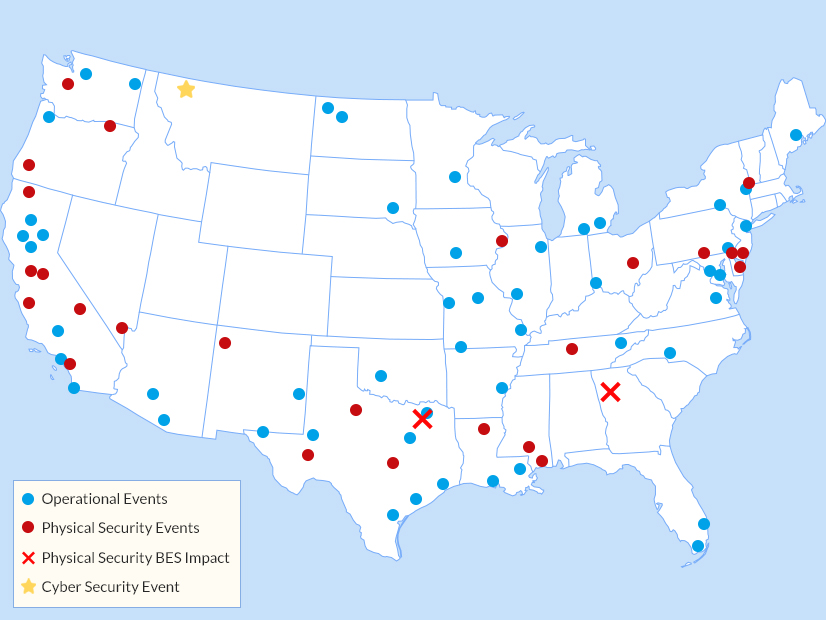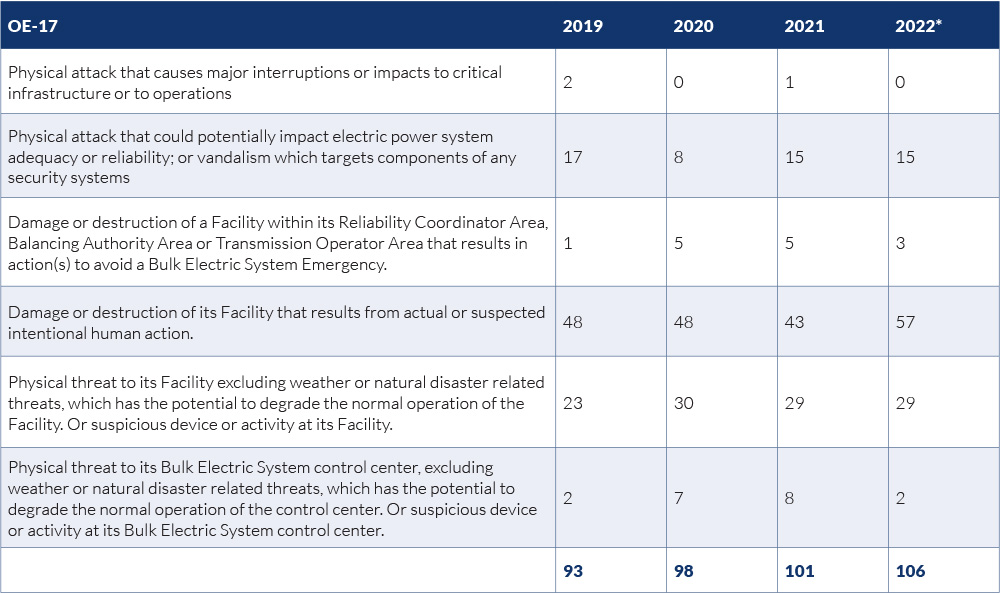
Fall has begun, so the nation’s transmission lines can expect to once again become a target. Specifically those porcelain or glass insulators.
 Tony Burt, NERC | NERC
Tony Burt, NERC | NERC
“Insulators on transmission lines are still a very popular target for people out in rural areas with a gun,” NERC’s Tony Burt said during his 2022 physical security overview at the ERO’s 10th Annual Monitoring and Situational Awareness Technical Conference on Sept. 22.
“Usually, about this time of year, we’re going to see an uptick in that,” said Burt, a physical security analyst in NERC’s Bulk Power Situational Awareness group. “There’s really not a lot we can do about it. People are just going to shoot insulators, because they’re a cool target, I guess; show your buddy how far you can shoot or how accurate you are.”
When it does happen, it may show up on a Department of Energy OE-417 report or a NERC EOP-004 filing — along with wayward drones, petty thefts and even protests near bulk electric system (BES) control centers, Burt said.
In 2020, NERC received three reports of physical threats to BES control centers, followed by one in 2021. There were none in the first half of this year, just as there were none in 2019. “Largely, those were due to civil unrest in major metropolitan areas. During that time, there were a lot of protests going on, as you’ll recall. Some of those control centers [were] in downtown areas or in areas where the protests were going on, and the protests might have gotten a little too close,” he said. “No impact to the BES operations, but an event nonetheless.”
 BPSA incident reports | NERC
BPSA incident reports | NERC
The most prevalent source of reports is also the most prosaic, Burt said.
“The majority of the … reports we see are theft-related; I don’t think I’m going to knock anybody’s socks off with that information,” he said. “You know, whether it be copper theft or construction materials or something that’s been left in a substation, or a catalytic converter ripped out of a vehicle that’s been left in a substation, or tools or anything else that criminals can get their hands on. Largely, when we see events where substation break-ins are taking place, it’s because of theft. That’s just the way it is.”
One new source of reports is drones that have crashed in utility facilities. Burt said it’s hard to tell if the drone operators had “a nefarious intent” or whether it’s just a curious and inexperienced operator.
“I think we really have to remember that we operate things that are pretty cool-looking to people that aren’t in the industry and don’t know about them. … They want to get cool video.”
Such incidents generally result in reports to local law enforcement, Burt said.
“Most times now, entities are getting law enforcement at some level involved in these things, because we don’t know why somebody’s out there taking pictures of a substation, or a power plant, or a transmission corridor or whatever. They may be writing a magazine article; they may be planning some nefarious plot that we’re not currently aware of.
“Back in the beginning of all of the standards … the FBI was the first one everybody wanted to call when something like this happened — because we thought they cared,” Burt recalled. “And over time, and being in different situations, [we realized] the local FBI office always doesn’t know what to do with that, or … as an engineer, they may not even know who the heck you are.”
Geospatial Displays Help Identify Trends
NERC shares physical security data in different forums, including with the regional entities, Burt said. “We’re always looking for trends; we’re always looking for something that we can get in front of, or we can share with people to say, ‘Hey, this is the current threat landscape.’”
To help identify trends, Burt’s group is beginning to use geospatial representations for some events.
“We’ve had instances where we’ve noticed a cluster of like events in different areas. You get different entities together, because, you know, although we can see all the reports, the other entities can’t, and they don’t know that their neighbor may have had similar incidents.”
Without the ability to “get in front of” trends, Burt said, “all of this data is just numbers.”
Warm Weather Miscreants
Although the 2022 data Burt shared ran only through the second quarter, the OE-417 reports included 57 incidents of “damage or destruction to its facility that results from actual or suspected human action” — more than in each of the last three full years.
“But we’re also getting to the time of year when the weather is getting worse,” Burt said. “And for whatever reason, criminals don’t like to go out in bad weather.”



